Want to Sell Stock Photos? Here’s a Comparison of Major Services
![]()
Up until just recently I always scoffed at selling my work as stock photography. Let’s call it youthful arrogance. I always felt my work was worth more and should be used for more important purposes. The problem was I wasn’t good at selling my work independently either.
However, now I had a new problem, which one do I go with? Each have their advantages and disadvantages and it can be hard to know where to list your images. After about 8 months of working with different agencies, I put together some thoughts on the major stock agencies and my experiences with each to help give others some guidance in the world of stock photography.
One general thought on selling stock before we begin: No matter what agency you sell through, do not expect to become rich by selling stock photography. Selling your work as stock might give you some nice supplemental income to help buy a lens or that tripod you always wanted, but most of the time it’s not going to pay the bills. These days there’s simply too much competition, and too much oversupply for most people to make a significant income from selling stock. Going into this with the right mindset is key to not getting discouraged.
Getty Images
That’s right, Getty, the big dog. Getty can make you some serious cash, but for a serious price. In the industry Getty is seen as having the highest quality and highest standards for their imagery, but nothing comes cheap; and while some might be drooling over the advantages I would urge people to seriously consider if the disadvantages are worth it.
Advantages
Potential Earnings: The biggest advantage to selling your work on Getty is how much money you have the potential to make. Keep in mind that word potential though before you get excited. A high res image is listed at $575. One of the most common contracts is with Moment Collection where you’ll earn 20%. Not bad right? $115 for a single sale of your photo. Even a low res photo (like the one you shot with your Canon 10D from 13 years ago) could sell for $375 earning you $75. No other agency even comes close to earning you that much.
![]()
Feel Good Factor: Another advantage is, well, pride. Getty has a reputation of quality. If your work gets in and even better, if it sells it’s a nice boost to your ego and can help motivate you to keep shooting.
Editorial: In addition to that, they offer Editorial classification of your images. This is important for people shooting things like travel or architecture. If getting a release is impractical and removing stuff from the photo would make it look terrible, you can simply classify it as Editorial Only and you can still sell it. Now the market for an editorial only image is smaller, but selling is better than not selling right?
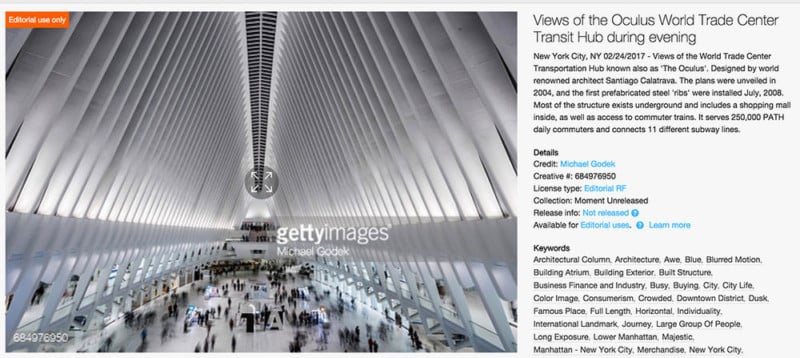
Submission Communication: Another nice feature is you have the ability to add notes to your submissions. If you have questions or concerns that you want them to consider when reviewing your work, you can write it in the notes section for the reviewer to read.
Creative Freedom: In my submissions to Getty I’ve noticed they are more artistically inclined than the other agencies. Let’s say you have a photo that’s blurry but conveys a strong emotion or story, they don’t reject it over “subject not in focus”. They are able to look past the technical and see the creative value in work.
Disadvantages
Exclusivity: The biggest disadvantage with Getty is that the contract is exclusive. That means anything you sell on Getty cannot be sold anywhere else. So all your eggs are in their basket with those images.
Submission Platform & Content Management: Next, their submission platform for contributors is awful. They even just finished a complete overhaul of the site and it’s still something that might as well be from 2003. You’d think by now they should have many years of feedback from contributors to develop the best site out there (especially with all the money their making with the other 80% of your photo sales). But no, it sucks.
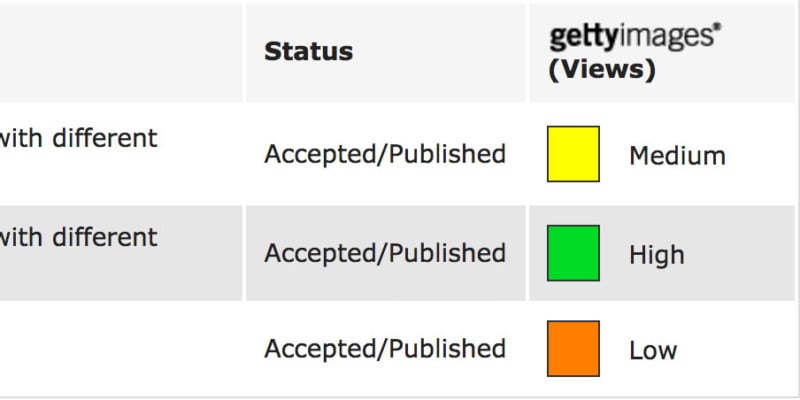
There is no visibility into image views other than a little square saying it’s getting “a lot” or “a little” in views. The photos are also organized in batches, which actually makes a lot of sense for the upload portion so that you can combine similar images in a single submission. But as a result, it’s impossible to see overall performance of all your work. Instead, you have to open each batch individually and view only those images in that batch to see how they’re doing. Most importantly, you don’t get to see sales of your images except for ONCE PER MONTH. Without being able to see views & sales in real-time, getting a good idea of your image performance is essentially non-existent. If you think about it, it’s absurd that they couldn’t invest their money into making a better submission platform and there’s no excuse for it.
Customer Service: With a poor site, you’d think maybe they have good customer service for their contributors. Well, unfortunately you’d be wrong there too. Every ticket I’ve submitted has taken months — literally months — to get resolved. After a poor site design and no customer service it makes it seem like all that money they make, just goes right into their pocket and they don’t invest in the company itself.
Content Review Times: Not fully a disadvantage, but definitely not an advantage is the content review times. These are completely unpredictable. They say up to 4 weeks to review and list for sale. The truth is, you never know. Some submissions will be reviewed and listed in a day or two, more commonly it takes about a week to get them reviewed, but I have seen them take even up to 6 weeks! It can be quite frustrating waiting that long to see feedback on the images and get them up for sale.
![]()
Earnings: Lastly, remember that word potential when talking about how much you’ll earn from your images. Well sadly that’s not normally the case, and even worse it seems that is actually becoming even less the case these days. They have what’s called “Premium Access” for high volume customers and it’s a negotiated rate they sell your work at. So that $115 you are hoping to earn? Try $3, or better yet $0.35. No joke. Half the time Getty is no better than the other microstock sites due to this Premium Access stuff….all the while your work is still exclusive.
iStock
iStock is a part of Getty Images and is one of the major players in the microstock market. Because of their association with Getty many of the things to consider are the same. But here are a few key differences.
Advantages
Exclusivity: The biggest difference between iStock and Getty is that iStock is not exclusive. That means you can sell your work on iStock as well as through other agencies.
Earnings Options: Another great feature iStock offers is optional exclusivity. While iStock enjoys a wider market (all the folks that can’t afford to pay $500+ for a photograph) that means you earn less because the price is lower. But with the option to sell exclusively through iStock while the images sell for less, you can earn a higher percentage – up to 45% – of each sale. This offers a nice balance of having access to a wider market while still earning a “reasonable amount” with each sale.
![]()
Disadvantages
Non-Exclusive Earnings: iStock is a microstock site, meaning you’ll earn next to nothing with each sale. The base rate for non-exclusive is 15%. With photos selling for $12, that earns you a hefty $1.80 per image. But, that’s only if it’s not a subscription customer. With most sales coming from subscription customers and, you guessed it, “Premium Access” expect to earn on average between 20¢ – 50¢ per sale.
Submission Platform: The other major disadvantage, they now use the same submission platform as Getty. So all the fantastically terrible things I mentioned previously with Getty, you have to deal with for iStock….and earn less money in the process. With that said, there are 3rd party applications you can use for submitting content that offer a much better experience both in uploading the content and with visibility into performance. But that just begs the question all the more, why isn’t Getty the one providing the quality experience to the people who are earning them money — the contributors?
Shutterstock
Shutterstock is arguably the king of microstock. They offer decent content for dirt cheap. As a result they have a pretty vast customer base.
Advantages
Content Management: Previously their user interface was pretty bad, but they’ve since released a major overhaul and unlike Getty/iStock this one propels them into the modern era. Their “Contributor Dashboard” gives you incredible insight into content performance in a number of ways, from real-time sales and earnings, to download location, to top performing content. It’s a lot of relevant information that you can use to better refine what to shoot and what to submit.
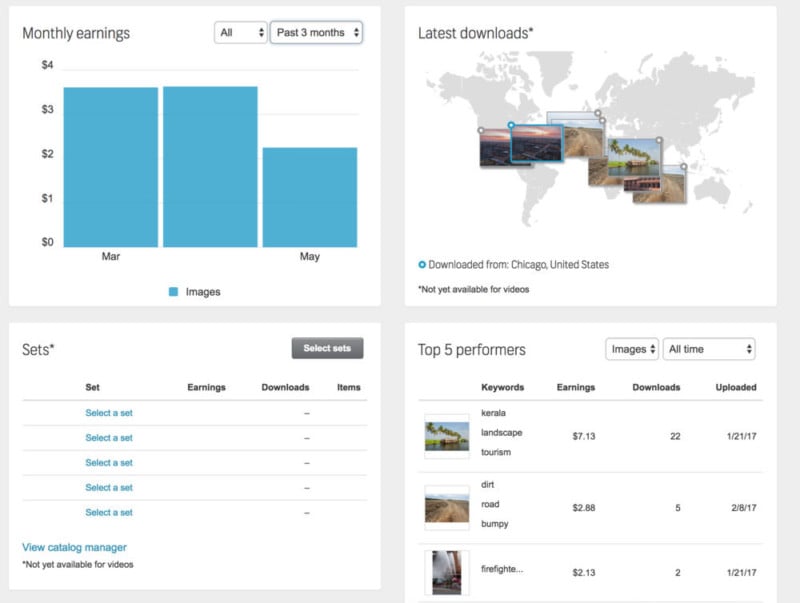
Market: Shutterstock also has an enormous customer base. Think about all the bloggers, small businesses, and other people who use imagery but don’t have a huge budget, that’s your audience. In addition, they also have a large international customer base. So it’s fairly easy to make sales even with all the competition.
Submission Review Time: Their submission review time is pretty good. The turn around is usually not more than several days, and I haven’t yet found myself asking “When are those pictures going to get reviewed”?
Editorial: They allow you to submit work for editorial use only, which is great. Unfortunately, due to their place in the market, I haven’t seen a major draw to any creative editorial content.
Exclusivity: Non Exclusive
Disadvantages
Earnings: Being more of a low-cost alternative to other agencies, you’ll be hard pressed to get more than $0.25 per photo. Don’t get me wrong it does happen, but most customers have subscriptions so that’s about the average you’ll earn for downloads. After some time it can get quite discouraging when you see “78 Downloads – Total Earnings $25.13”. Not gonna be bringing home the bacon with that kind of return.
![]()
Submission Platform: Another thing is while their Contributor Dashboard is nice, their upload/keywording page is still pretty clunky. It’s functional, but not modern and sleek like the dashboard.
Adobe Stock
Adobe Stock is the newest player in the game. Launching almost exactly two years ago in 2015, and with much admiration, it has some of the best qualities of each of the other sites while trying stay competitive in the market.
Advantages
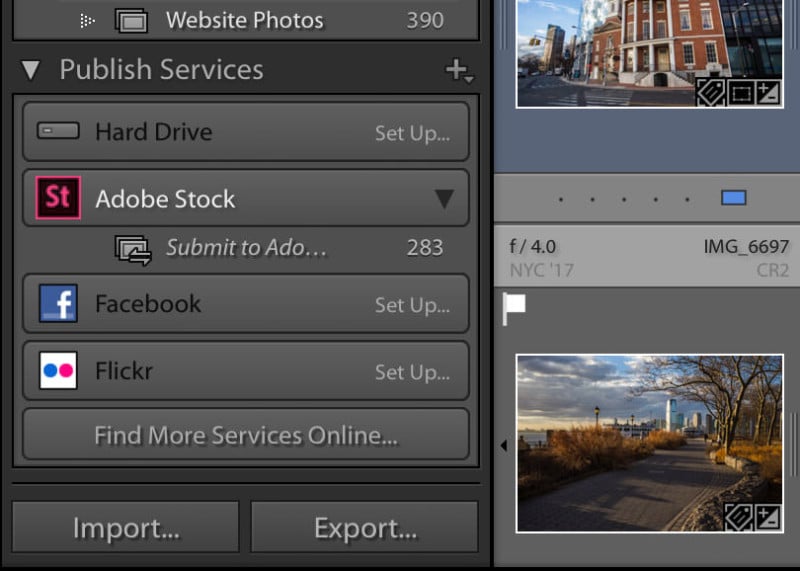
Workflow: They are fully integrated into Adobe CC software, specifically Lightroom. As a contributor, all you have to do is drop your photos in the Adobe Stock publishing area and it will upload it for you, ready for you to add keywords and titles. Not only does that make it seamless to upload content, but also makes it seamless for customers to test content within programs like Photoshop and InDesign. By integrating Adobe Stock into Adobe CC they make everyone’s lives a little easier.
Submission Platform & Content Management: Their submission platform, and content dashboard are completely modern. It’s almost as if Adobe looked at what everyone else was failing to provide and included it in their design, then built it from the ground up. It gives you individual stats on every photo, real-time sales, and a beautiful, easy to navigate interface. There are a few things that could be improved on like bulk actions and maybe adding graphs, but overall it works well.
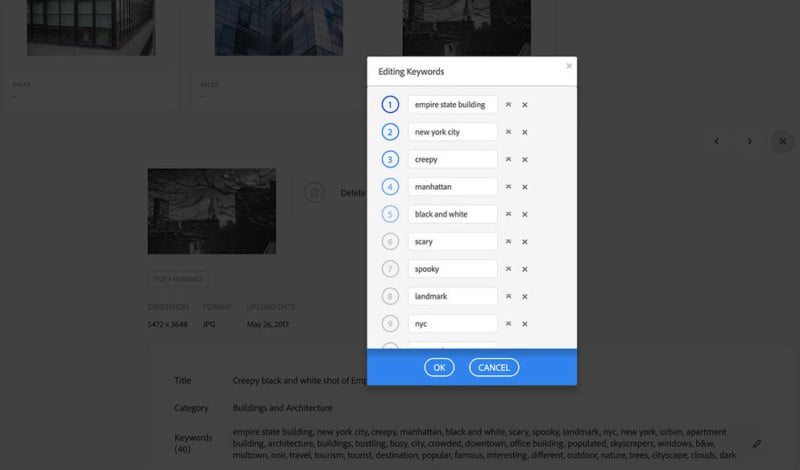
Adobe also gives you the ability to edit after publication. Let’s say there’s a good keyword you didn’t think of when you submitted the image, well Adobe lets you edit the submission after the fact! So you can add keywords, change the title, adjust what keywords are most relevant, etc.
Note: It’s important to note while they did offer a “Views” stat for each image, that has since been taken down due to inaccurate information. But they do plan to add it again when it’s fixed.
Submission Review Time: Of all the agencies, Adobe is ranks at the top for this one. They have been very quick and consistent to turn around images that are submitted. Submissions seem to get reviewed in just a day or two on average.
Earnings: I decided to put this in the advantages just due to the overall experience with Adobe Stock. The earnings are neither good, nor bad. Adobe is a microstock site, meaning that you won’t earn much. However, while you might earn pennies on Shutterstock, you can earn dimes on Adobe. $0.20 is the lowest I’ve seen a sale for, and $3.33 is the highest (for their standard contributors). Recently though, I’ve noticed many images selling for $0.99. And in my mind, $1 per image isn’t all that bad, and can add up quickly.
Customer Service: Every time I’ve had a question or an issue, they have responded within 24 hours. Not only that, they have explained things and answered follow-up questions with the same speed and effort as the original request. Big thumbs up here!
Exclusivity: Non Exclusive
Disadvantages
Content Approval: While they are only a microstock site, their pickiness for the technical execution and releases is a bit extreme. I’ve had photos rejected that were properly exposed night shots, for being “under-exposed” or a shallow DOF shot for “image out of focus”. Their strictness on what is considered intellectual property is also way too stringent.
![]()
If anything looks at all unique in character and it doesn’t have a release, it’s almost guaranteed to be rejected. Even if there’s no possible way to identify what the photo is of. In addition, it’s totally unpredictable. You might get one image of fancy windows get approved, then another of the same windows get rejected for “Intellectual Property Refusal”. My guess is at the moment, they are trying to build a quality library of images and avoid legal battles so they are being extra picky since they’re just starting out. Maybe this will ease as time goes on.
Creative Freedom: This goes hand in hand with what’s above. The content they’re looking for is generic, wide market interest. They don’t want something they conveys an emotion, they want standard stock with smiling teeth, lifestyle, and bright environment. Now, I’m sure that’s what they want because that’s what sells, so can you blame them? But, if you consider yourself an artist, you can find it quite stifling to see a quality image get rejected for “No Aesthetic or Commercial Appeal”.
Editorial: They don’t allow images to be submitted as Editorial Only. So if you don’t have a release for something, it simply won’t get accepted….no way around it. This may be a big deal or it may not, depending on what you shoot. For someone shooting travel, this poses a big problem. Since, while traveling you can’t always get a model/property release, this would leave a good handful of images that you shoot completely unusable.
Company Establishment: Adobe Stock is in its early stages and they’re still establishing themselves. They have a solid brand behind them, and a large following in the creative community, but they’re still young. You’re bound to run into hiccups with the technology, and potentially see lower sales volume. In reality, I fully expect their market share to grow significantly, and for them to be a “heavy hitter” in the stock world. But for now they are still young and building a solid customer base.
I hope this can give a little insight into the world of stock photography from a newcomer with a fresh perspective. With that I’ll leave you with one final thought. Don’t get discouraged at the rejections. So many images will get rejected for various reasons. But you’ll also be surprised at some that get accepted… or better yet, that sell! You never know what will make you money, so just submit everything you have and let them decide what is or is not sellable. Then do the same at the other agencies. You’ll often find that what one agency rejected, another will accept (and even make sales from). So don’t let the rejections get you down.
Good Luck!
About the author: Michael Godek is a portrait and fine art photographer, traveler, entrepreneur, and teacher based out of Indianapolis, Indiana. The opinions expressed in this article are solely those of the author. He’s also the founder/owner of Lightbox Photo Academy. You can find more of Godek’s work on his website. This article was also published here.